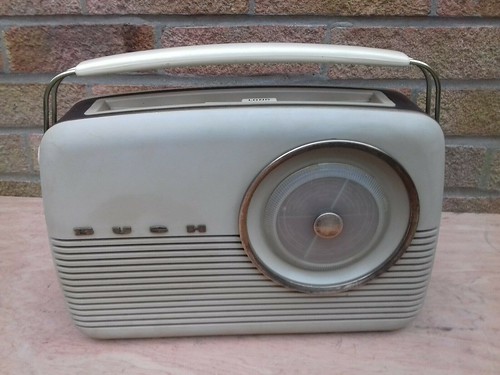5 minutes estimated reading time
Whilst you might not know the Bush TR 82, if you were from western Europe you’ll recognise its style immediately.
Post-war Britain
In the post-war era Bush Radio Limited tried to fill consumers demands for entertainment.
There were radios that would sit on a sideboard and would have the presence of a TV set. Many of these have fitted out with Bluetooth to create a better sounding sound system. It certainly sounds better than an Amazon Echo. My parents inherited one of these, a Bush VHT 61, which served them well for many years.
There was also radiograms, which is were a cross between a sideboard and a hifi system.
The secret of their warm sound was valve circuits. Before chips with millions of components, were transistors. And before transistors were delicate lightbulb-like valves.
David Ogle’s iconic design
Over time manufacturers like Bush managed to make valves small enough to make portable devices. In 1957 the Bush MB60 was launched. This was a portable valve radio designed by David Ogle of Ogle Design. The MB60 didn’t last as even minature valve radios were power hungry and delicate. But David Ogle’s case design lived on.
TR 82
Ogle’s product design was mated to a seven transistor circuit to create the TR 82.The TR 82 was big enough to have a decent sound and small enough to be portable. Alkaline batteries like Duracell were only starting to reach the market about the same same as the TR 82. So a high powered long lasting battery would be a 9 volt lantern style battery. This meant that you got months of use out of one battery, but each battery was expensive. (Similar batteries were still commonly used up until recently in the flashing lanterns used to mark road works currently in progress).
The TR 82 received long wave and medium wave so didn’t need an external aerial. VHF or FM radio wasn’t popular yet. In common with cars from the 1950s the Bush TR 82 had chrome plated brightwork. This was around the front panel around the edge of the circular reception dial. Despite this ornamentation you ended up with a very intuitive radio design, with a simplicity that Dieter Rams would appreciate. There was a large tuning wheel on the front of the radio.
On top, there were two rotating controls:
- Volume
- A combined tone and on / off switch
Selection between medium wave and long wave reception was done with two large buttons.
The handle ran the length of the case and swivelled at the points at which it was secured. This provided even easier access to the top controls of the radio.
The rear cover was removed by a single central screw. This could be undone with a edge of a coin. Inside the case was a battery compartment at the bottom. The rest of the radio was held on a metal subframe. This rigidity was essential for the tuning mechanism to work seamlessly and for the speaker to provide a good sound.
My personal memories of the TR 82
My own personal memories of a well-used and obsolete Bush TR 82 stem from my time on the family farm in Ireland. The radio lived in the kitchen and provided news at lunch and dinner time. It was also turned on to listen to the latest livestock market prices. This would then affect if, or when livestock and wool were sent to market. It provided live music on a Saturday evening. In essence, it filled many of the tasks that an internet enabled PC would do – if my Uncle and Grandmother had been online.
Radio was the primary media. Ireland had been an early adopter of radio, but a relative latecomer to television. So even into the early 1980s the radio had a pre-eminence in consumer behaviour that was only slowly eroded by the TV.
Television was something only broadcast from after lunch until late evening, apart from the weekends. When the second TV channel launched it only during the evening. By comparison at the time radio broadcast from before 6am in the morning until shutdown just after midnight.
TR 82 and the rise of Sony
The timing of the Bush TR 82 was a high point. The same year Tokyo Tsuskin Kogyo launched the first pocket sized transistor radio – the TR-63. It was the first ‘Sony’ product to be sold in the US. Sony was originally a product line brand for their nascent transistor radio busness. The product was so successful that the founders changed their company name to Sony Corporation. This idea of portable pocket entertainment begat personal stereos, iPods and the smartphone. (You can find more on Sony here.)
By comparison the TR 82 marked the point for Bush Radio as well. Bush Radio had been acquired by Rank in 1945. In 1962, the company was merged with Murphy Radio as Rank Bush Murphy. This was sold to Great Universal Stores in 1978. In 1986, the Bush name was sold to the Alba Group. In 2008 the former Alba Group sold the name for use outside Australasia on to Home Retail Group. Sainsburys acquired Home Retail Group in 2016.
But the iconic Bush TR 82 shape lived on, in more modern, yet poorer quality replicas. Most noticeably the Bush TR 82 DAB which had digital radio, FM, medium wave and long wave. Unfortunately the modern radio didn’t feature the same quality of speaker or internal frame. This meant that the sound suffered from lower power and a muddy sound caused by vibrations in the case. A brief feature on the Bush TR82 by the BBC and the British Museum here.
